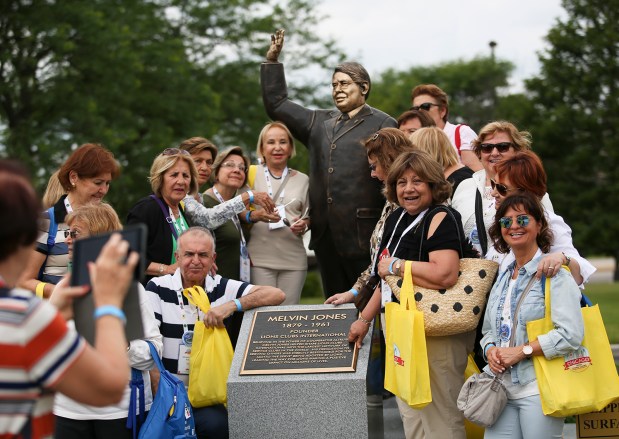The Frankfort Firefighters Local 4338 has begun posting on social media when fire stations are unmanned as a measure of public safety, the union president said, following the recent temporary closing of a station as firefighters attended training.
The union posted on its Facebook page that Station 74, 7990 W. Steger Road, was to be closed from 8 a.m. to 4 p.m. Feb. 28 due to staffing. Union President and Frankfort Fire Protection District Lt. Nicholas Sunzere said three firefighters were at training.
Station 74 being unmanned was the result of poor planning, Sunzere said.
“Sometimes you just got to say, ‘Hey, we can’t do certain things’ because what’s more important is we need to be able to respond to calls and just plan appropriately,” Sunzere said. “We think it’s important for them to know, public safety wise, that if you call 911 there might be a delayed response.”
Fire Chief Sean Fierce said it is common for a fire station to be unmanned for various lengths of times while fire crews are at training, department physicals, the mechanics, grocery shopping or when a firefighter takes an unexpected personal or sick day.
Fierce said fire crews need to go to training. The decision to have Station 74 unmanned Feb. 28 was within the collective bargaining agreement that states management can close a station for up to nine hours for training.
“I am not going to stop members from going to training. I am following the collective bargaining agreement,” Fierce said. “This is an agreed-to practice, and it has been going on consistently this way for years.”
Fire officials weren’t pleased with the union’s post about the unmanned station, Sunzere said.
“It wasn’t their favorite thing we did, but they didn’t retaliate against us,” Sunzere said.
In response to the union’s new social media policy, Fierce said there could be questions about the definition of unmanned. When crews go grocery shopping, to the mechanic, to a school to teach children about fire safety or to respond to a 911 call, the station is unnamed, he said.
“They’ll probably be posting it daily,” Fierce said. “I don’t know, in all these instances, are they going to post that or not.”
On Feb. 28, when Station 74 was unmanned, the district responded to 18 calls, Fierce said. None of those calls were in Station 74’s response area, he said.
Of the fire district’s five fire stations, Fierce said Station 74 has the fewest number of calls, so it is common for management to shift staff to the other stations, which are in busier sections of the district.
The Frankfort Fire Protection District has 60 firefighters, Sunzere said. The district has 20 firefighters assigned a given shift, but very often 16 firefighters, the minimum staffing agreed to in the department’s contract with the union, are working the shift.
That manpower model was established in 2014 when the department handled about 3,500 calls a year, Sunzere said. For the last four years, the union has been calling for more firefighters on a shift, he said, as the department has seen an increase to about 5,500 calls.
“For a while, it was acceptable and we could deal with it. It made sense because that station was a little bit slower than the rest of the stations,” Sunzere said. “The union has been much more vocal that when you take that station down and take all three guys out of there, it makes it so that the more densely populated stations … they’re now covering that area depending on where that calls at.”
For example, Sunzere said when Station 74 is unmanned, Station 71 in downtown Frankfort serves Station 74’s area, about a 10-minute response time at its farthest point.
If the Station 71 engine is called into Station 74’s region, Sunzere said it takes away the main engine that serves as fire protection and EMS calls for the downtown area. It would also take away the back up engine to Station 72, Station 73 and Station 75 for structure fires, he said.
When Station 74 is unmanned, Station 72 and Station 75 also get stretched to cover the area, Sunzere said. Station 75 has three firefighters, he said, so if the crews have to respond to a call in Station 74’s area, then Station 75 becomes unavailable for calls within its area.
“Shutting down a station like 74 and a call comes into 74, essentially shuts down two to three still districts for a response,” Sunzere said.
Station 74 was unmanned 15 times in 2023 because crews had training or department physicals, Sunzere said. When the station was unmanned, Sunzere said the length of time was anywhere between one hour to 10 hours.
The union isn’t going to file a grievance because there was no contract violation, Sunzere said.
“If they want to keep on doing that, that’s fine, that’s their prerogative. They have the right to do so. But we’re going to take the steps of letting the village know they’re not protected between this hour and this hour,” Sunzere said.
Both Fierce and Sunzere said they would like to see the department hire more firefighters. Fierce said his goal is to work with the village’s finance department to see if the upcoming budget, which begins June 1, could accommodate an increase in staffing.
akukulka@chicagotribune.com





